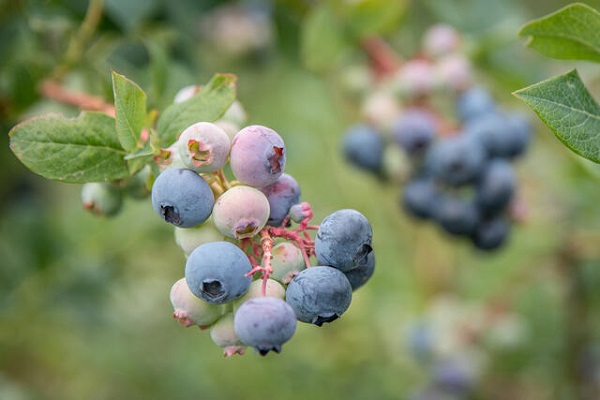Following the start of the blueberry harvest in southern and central Germany, the blueberry season is now also beginning in Germany’s largest blueberry growing region: the North German Plain. Lower Saxony is the center of German blueberry cultivation, with about 2,000 hectares (ha) under cultivation and around 70 percent of production.
If the weather remains moderate, the main harvest in the open field will take place this year in the period from mid-July to early August. Currently, blueberries are already being harvested in the weather-protected foil tunnels. Berry cultivation experts at the Lower Saxony Chamber of Agriculture (LWK) expect good fruit quality and a growing harvest.

Blueberries ripen in a field at the Lower Saxony Chamber of Agriculture’s Berry Fruit Experiment Station in Vechta-Langförden. The LWK’s soft fruit experts expect good fruit quality and a harvest volume of around 11,000 to 13,000 tons. Photo: © Wolfgang Ehrecke
“Here in Lower Saxony, most blueberries have ideal growing conditions because they grow on heath or moorland sites, their natural habitat,” reported Felix Koschnick, head of the LWK’s Berry Fruit Experiment Station in Vechta-Langförden.
Koschnick emphasized that not just the location, but also the weather is important for the success of the cultivation. Although the spring frosts had led to a regionally very different reduction in the harvest volume again this year, the damage was less than in 2020, he said, adding that wind-open moorland locations had been hit hardest by the frost.
“That’s why, despite the challenging weather, we’re more optimistic than last year about a total statewide harvest of 11,000 to 13,000 tons,” said the head of LWK’s soft fruit trial station. Last year, 160 farms (2019: 162 farms) in Lower Saxony harvested a total of 6,743 tons (2019: 9,780 tons) of cultivated blueberries, according to the State Statistical Office.
Thus, according to current forecasts, consumers will have sufficient blueberries from Lower Saxony available this summer: in fields for self-picking, in direct marketing and in food retail.
Blueberries from domestic production have relatively short transport distances compared to imports. Thanks to a combination of varieties with different ripening dates, the blueberry season in Lower Saxony will last until mid-September.
A major concern for the farms is still whether they will be able to get enough qualified harvest workers in time under the conditions of the Corona pandemic. “Experience during the asparagus and strawberry harvests has shown that much can be organized and handled by the family-run farms, even if major logistical challenges demand everything from the farm management,” Koschnick reported. “The long-standing, trusting relationship and cooperation with their seasonal workers and permanent employees* is an important factor here.”
For more information:
Landwirtschaftskammer Niedersachsen
Mars-la-Tour-Straße 1 – 13
26121 Oldenburg
Tel: 0441 801-0
Fax: 0441 801-180
E-Mail: info@lwk-niedersachsen.de
Web: https://www.lwk-niedersachsen.de/


